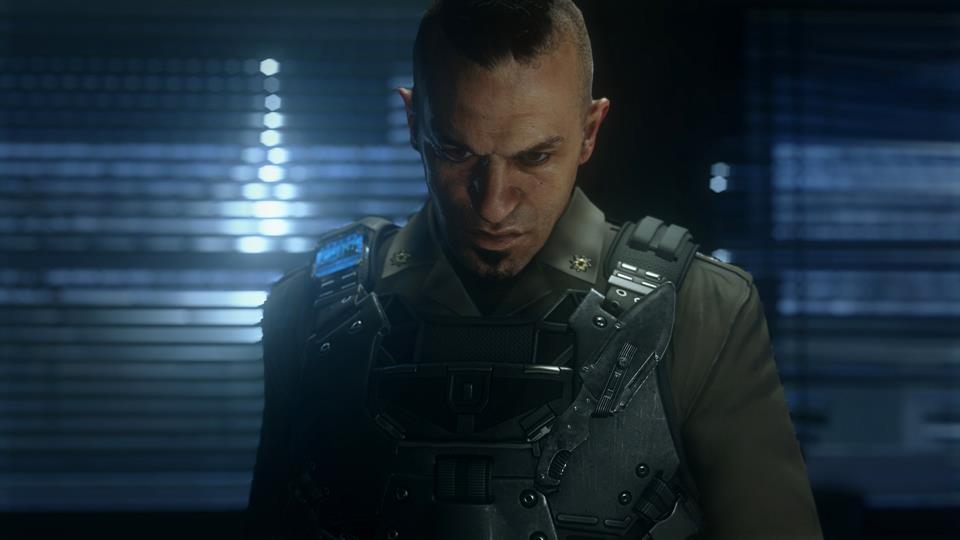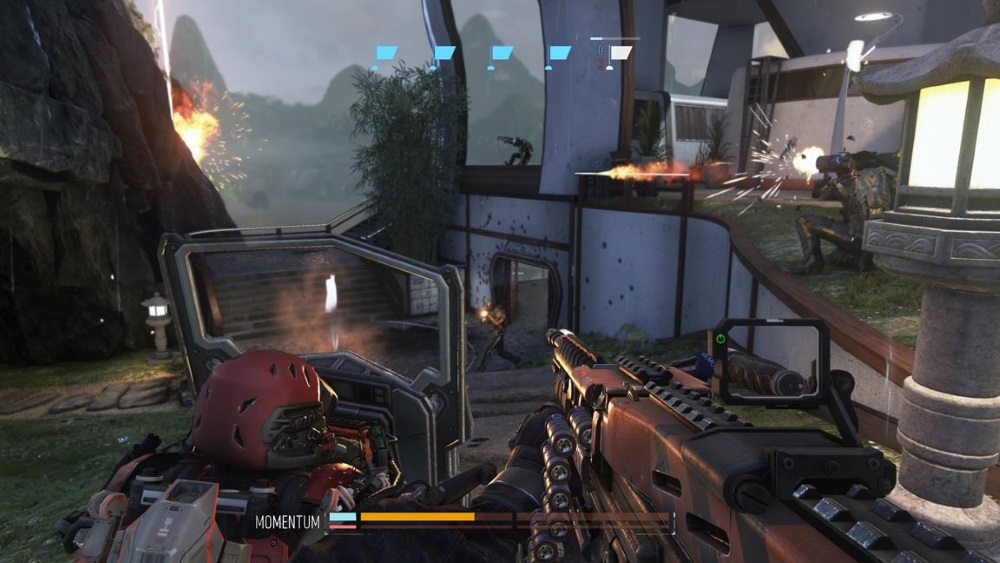How an RPG loot system, obscene amounts of customisation and a single-player campaign you care about will shake up Call of Duty.
“We’ve gone through so many more prototypes. If we made a mistake on something, it was okay. It also gave us a lot of time to create new tech, a new engine and tools.”
Sledgehammer Games is throwing a lot at Advanced Warfare to make Call of Duty a significantly different game this year.
An annual franchise, the series needs new life if it’s to continue to push first-person shooters forward. Destiny, Titanfall and Battlefield Hardline are all trying new things – Advanced Warfare has to be just as ambitious.
“How do we get some new types of gameplay in there that really changes things?” asks Sledgehammer co-founder Glen Schofield at a recent press tour for the game. “How do we continue to keep the millions of people already playing engaged in the game, and bring new players on and keep them, after all these years?”
Perhaps the biggest difference Advanced Warfare has had over its predecessors is time. This is a game that’s spent three years in development, not two, letting Sledgehammer pound out version after version, tweak after tweak, and try new things, whether they fail or not.
“We’ve gone through so many more prototypes to iterate on and make changes. If we made a mistake on something, it was okay. It also gave us a lot of time to create new tech, a new engine and tools,” he says. The PS4 and Xbox One technology has also been crucial to changing Call of Duty: “To think about the power and the capabilities that next-gen gives us. It really changes how we design because they are about ten times more powerful.”
But it’s the gameplay that matters before technology. How do you change a military shooter built around realistic weapons and real-world confrontation? You bump it forward 50 years in the future and give your soldier an overpowered exoskeleton.
“You are the advanced soldier,” says Schofield. “That’s been our mantra throughout. It’s very important for us to maintain that. We have to make the player feel like they are a tier one operator 50 years in the future.”
“It started with the HUD. We wanted to pull everything off the HUD and just give you as much screen as we could. That helps immerse you, and then we can take all the information and get it in the screen so you feel like you’re right there.”
And once you’re there, Sledgehammer adds the gadgets until you’re fit to burst. Augmented reality vision, threat detection, smart grenades, energy weapons, hover bikes, walking turrets. Weapons that aren’t sci-fi, but are the 50-year evolution of what the military carts around today.
“We took a small team and dedicated it to just weapons. They spent their three years researching, designing, creating the new firepower. Taking old weapons from the past and seeing how much they changed over the course of 50 years and then extrapolating that out,” details Schofield.
The real star though is the exoskeleton. Not only does it make your soldier tougher, it changes the way the player moves. Like Titanfall and to some extent Destiny, you’re no longer stuck to the ground beneath your feet or stairs and ladders to get a higher position. What these games are doing is adding the classic platformer double-jump. It’s ridiculous and completely cool at the same time.
“The heart and soul of this game is the exoskeleton. It was the very first idea from three years ago,” says Schofield.
“The most fundamental change comes in the player movement,” he continues. “When you add boost jump, boost slide, boost dodge and boost slam it changes not only the way the game is played, but the way we had to design the levels.
“For the last ten years we’ve been designing levels where you run-and-gun, upstairs, climb ladders – but now we’ve added verticality. We throw all that other stuff out and rethink the whole design. Some of these levels in multiplayer and singleplayer have taken two years to develop. They feel like they’re handcrafted.”
“Some of these levels in multiplayer and singleplayer have taken two years to develop. They feel like they’re handcrafted.”
The maps I’ve played do feel different to standard Call of Duty. I like the vertical climb the suit gives me, but I’m not sure if it made maps feel smaller. The exo suit had me dodge out of the way of fire successfully, the boost jump is great for reaching higher ground quickly, and the shield and grenade-launching gadgets are neat as hell.
I’ve only played multiplayer for 90 minutes, but I didn’t get bored, and the key to this was the all-new customisation system. Expanding Black Ops 2’s Pick 10 system to Pick 13 – you basically have 13 slots to fill with weapons, perks, gadgets, scorestreaks and more
“If the overall game mantra was ‘you are the advanced soldier’, then multiplayer was about you playing your own way. We wanted to make sure there was more personalisation and customisation than we’ve had in multiplayer before,” offers Schofield.
We hear about customisation in all games a lot, and it’s clear that Sledgehammer has worked to offer more variety than ever before. In a world where players gripe about not unlocking enough items in Destiny (it’s called a “rare engram” for a reason), Advanced Warfare may be spoiling its players with a design borrowed from the best MMORPGs.
“Supply Drops are our loot system,” he says. “Anytime you decide to bite off on doing a loot system, it’s a major thing. This is something that we’ve wanted to get in since day one. It took us three years to get it in. It gives everybody the opportunity to get stuff.”
“In development you plan how many different options you’re going to create for customisation. And then near the end you have some time left and the artists have gotten a little faster. We were doing some rough math and we have over 20 billion different combinations for creating operators. So the chances of any two of you looking the same are pretty low,” laughs Schofield.
So you can add fairness in multiplayer to the list of improvements for Call of Duty, alongside obscene amounts of choice for your loadout.
Which just leaves the multiplayer maps. Again, the exoskeleton provokes a new approach to map design. But there also seems to be another number of inventive takes on maps and competitive play; whether that’s an incoming tidal wave forcing players to move to higher ground in the middle of a match or the Uplink mode – a kind of American Football game that seems designed for eSports – Sledgehammer’s take on the exoskeleton and the changes that makes goes far beyond novelty.
Next: is the idea that no one buys Call of Duty games for the singleplayer campaign a myth?




Comments
Post a Comment